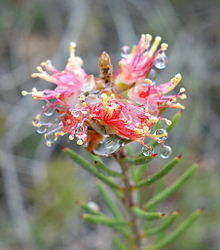Melaleuca brachyandra
| Melaleuca brachyandra | |
|---|---|
 |
|
| M. brachyandra at the University of California Sant Cruz arboretum | |
| Scientific classification | |
| Kingdom: | Plantae |
| (unranked): | Angiosperms |
| (unranked): | Eudicots |
| (unranked): | Rosids |
| Order: | Myrtales |
| Family: | Myrtaceae |
| Genus: | Melaleuca |
| Species: | M. brachyandra |
| Binomial name | |
|
Melaleuca brachyandra (Lindl.) Craven |
|
| Synonyms | |
| Callistemon brachyandrus Lindl. | |
Melaleuca brachyandra commonly known as prickly bottlebrush or scarlet bottlebrush is a plant in the myrtle family, Myrtaceae and is endemic to New South Wales, Victoria and South Australia in Australia. (Some Australian state herbaria continue to use the name Callistemon brachyandrus.) It is a shrub or small tree with narrow leaves and showy red and green flowers making it an ideal ornamental plant in temperate areas.
Melaleuca brachyandra is a shrub growing to 1.5–8 m (5–30 ft) tall with hard bark and a rigid habit. Its leaves are arranged alternately and are 18–61 mm (0.7–2 in) long, 0.5–1.7 mm (0.02–0.07 in) wide, linear in shape, kidney-shaped in cross section and with the end tapering to a sharp point.
The flowers are arranged in spikes on the ends of branches which continue to grow after flowering. The spikes are up to 35 mm (1 in) in diameter with 7 to 36 individual flowers. The petals are 2.8–4.9 mm (0.1–0.2 in) long and fall off as the flower ages. There are 50 to 84 stamens in each flower, with their "stalks" (the filaments) rich crimson and "tips" (the anthers) green. Flowering occurs from September to January and is followed by fruits which are woody capsules, 9–12.4 mm (0.4–0.5 in) long.
Melaleuca brachyandra was first formally described in 2006 by Lyndley Craven in Novon. It had previously been known as Callistemon brachyandrus since John Lindley described it in 1849 in Journal of the Horticultural Society of London. The specific epithet (brachyandra) is from the Ancient Greek brachys meaning “short” and andros meaning "male" referring to the length of the stamens being shorter than the styles.
Melaleuca brachyandra occurs in scattered inland areas of New South Wales, mostly commonly in the Cobar district. It also occurs in the lower Murray River districts of north-western Victoria and south-eastern South Australia.
...
Wikipedia
